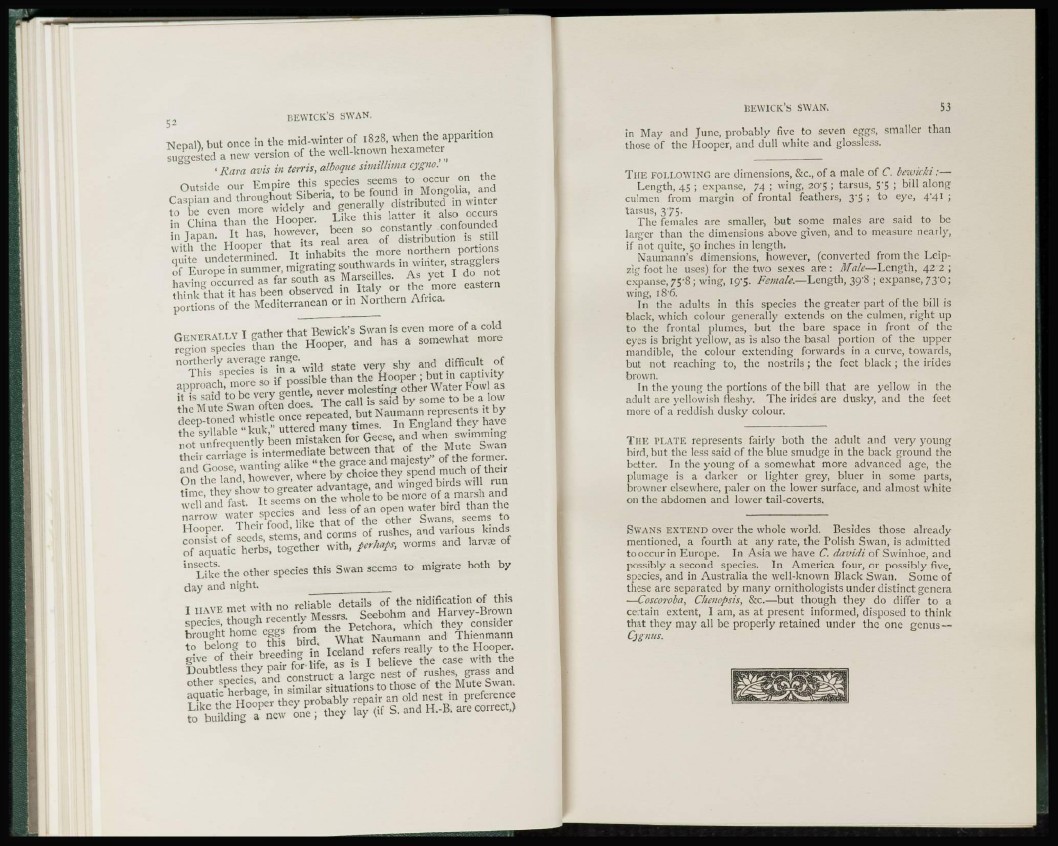
BEWICK'S SWAN.
Nepal), but once in the mid-winter of 1828, when the apparition
suggested a new version of the well-known hexameter
' Rara avis in terris, alboque simillima cygnol "
Outside our Empire this species seems to occur on the
Caspian and throughout Siberia, to be found in Mongolia, and
to be even more widely and generally distributed in winter
in China than the Hooper. Like this latter it also occurs
in Japan. It has, however, been so constantly confounded
with the Hooper that its real area of distribution is still
quite undetermined. It inhabits the more northern portions
of Europe in summer, migrating southwards in winter, stragglers
having occurred as far south as Marseilles. As yet I do not
think that it has been observed in Italy or the more eastern
portions of the Mediterranean or in Northern Africa.
GENERALLY I gather that Bewick's Swan is even more of a cold
region species than the Hooper, and has a somewhat more
northerly average range.
This species is in a wild state very shy and difficult of
approach, more so if possible than the Hooper ; but in captivity
it is said to be very gentle, never molesting other Water Fowl as
the Mute Swan often does. The call is said by some to be a low
deep-toned whistle once repeated, butNaumann represents it by
the syllable "kuk," uttered many times. In England they have
not unfrequently been mistaken for Geese, and when swimming
their carriage is intermediate between that of the Mute Swan
and Goose, wanting alike " the grace and majesty" of the former.
On the land, however, where by choice they spend much of their
time, they show to greater advantage, and winged birds will run
well and fast. It seems on the whole to be more of a marsh and
narrow water species and less of an open water bird than the
Hooper. Their food, like that of the other Swans, seems to
consist of seeds, stems, and corms of rushes, and various kinds
of aquatic herbs, together with, perhaps, worms and larva of
insects.
Like the other species this Swan seems to migrate both by
day and night.
I HAVE met with no reliable details of the nidification of this
species, though recently Messrs. Seebohm and Harvey-Brown
brought home eggs from the Petchora, which they consider
to belong to this bird. What Naumann and Thienmann
give of their breeding in Iceland refers really to the Hooper.
Doubtless they pair for life, as is I believe the case with the
other species, and construct a large nest of rushes, grass and
aquatic herbage, in similar situations to those of the Mute Swan.
Like the Hooper they probably repair an old nest in preference
to building a new one; they lay (if S. and H.-B. are correct,)
BEWICK'S SWAN. 53
in May and June, probably five to seven eggs, smaller than
those of the Hooper, and dull white and glossless.
THE FOLLOWING are dimensions, &c, of a male of C. bewicki:—
Length, 45 ; expanse, 74 ; wing, 20'5 ; tarsus, 5'5 ; bill along
culmen from margin of frontal feathers, 3'5 ; to eye, 4'4i ;
tarsus, 375.
The females are smaller, but some males are said to be
larger than the dimensions above given, and to measure nearly,
if not quite, 50 inches in length.
Naumann's dimensions, however, (converted from the Leipzig
foot he uses) for the two sexes are: Male—Length, 4 2 2;
expanse, 75'8 ; wing, 19-5. Female.—Length, 39/8 ; expanse, 73x3;
wing, 18(5.
In the adults in this species the greater part of the bill is
black, which colour generally extends on the culmen, right up
to the frontal plumes, but the bare space in front of the
eyes is bright yellow, as is also the basal portion of the upper
mandible, the colour extending forwards in a curve, towards,
but not reaching to, the nostrils; the feet black; the irides
brown.
In the young the portions of the bill that are yellow in the
adult are yellowish fleshy. The irides are dusky, and the feet
more of a reddish dusky colour.
THE TLATF. represents fairly both the adult and very young
bird, but the less said of the blue smudge in the back ground the
better. In the young of a somewhat more advanced age, the
plumage is a darker or lighter grey, bluer in some parts,
browner elsewhere, paler on the lower surface, and almost white
on the abdomen and lower tail-coverts.
SWANS EXTEND over the whole world. Besides those already
mentioned, a fourth at any rate, the Polish Swan, is admitted
to occur in Europe. In Asia we have C. davidi of Swinhoe, and
possibly a second species. In America four, or possibly five,
species, and in Australia the well-known Black Swan. Some of
these are separated by many ornithologists under distinct genera
—Coscoroba, Chencpsis, &c.—but though they do differ to a
certain extent, I am, as at present informed, disposed to think
that they may all be properly retained under the one genus—
Cygnus.